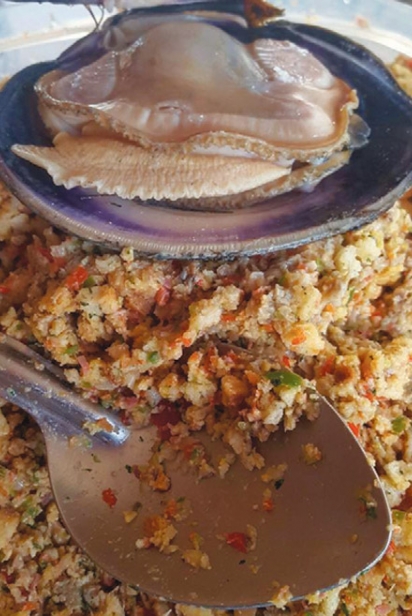Wampanoag Shells
Growing up on Cape Cod, Marcus Hendricks spent as much time as he could outdoors and on the water. He’d head out to the quahog flats with his family and go shellfishing, collecting quahogs or clams or crabs, and returning home to eat what they had collected. Hendricks says being on the water just seemed like second nature to him. “Whatever I was doing it had something to do with water. I liked shellfishing, it wasn’t difficult for me, and I enjoyed being outdoors in nature.”
Hendricks’ own roots are Wampanoag and Nipmuc, two of the Native American tribes who were on the Cape before European colonists arrived. He grew up having one foot in the traditions of his family, and the other part of the modern world of school and a collegiate path. Upon finishing college, where he studied both business administration and anthropology, Hendricks sought to start a business that would combine the two. “I wanted to incorporate both parts of my world and create a business that doesn’t feel like a job,” he says.
Hendricks’ business does just that: he is able to combine shellfishing, jewelry making, and cookery into a 100% sustainable and waste-free business called Wampanoag Shells. The nature of the business is seasonal in that on the shellfishing side Hendricks harvests what’s in season, no matter the weather, but it’s cyclical and the species change. In the fall, it’s quahogs, scallops and oysters, and when the ice starts to come in, he’ll head out and break the ice and collect clams and quahogs with a rake. Spring and summer are for softshell clams (steamers), quahogs, blue mussels, conch or whelk, periwinkles and crustaceans like rock crab or lobster. Hendricks’ first order of business is to eat, to get nourishment from the natural resources he’s harvested, and in Wampanoag tradition, honor and give thanks for the gifts provided by Mother Earth.
A respect for nature was a big part of the teachings he was raised with. “I was taught that you use everything, every part, and there should be no waste,” he says. Hendricks sorts the leftover quahog shells, setting aside those with a beautiful (and highly desirable) purple marbling throughout. Those shells will be used to create Hendricks’ one-of-a-kind wampum jewelry. The jewelry making tradition has been a strong one for the Wampanoag, one that Hendricks has carried on with the creation of breathtaking necklaces, bracelets, earrings and rings. Even shells without the purple hue are used; some have attractive brown or grey tones woven throughout. Smaller shell fragments get put in a tumbler and in themselves can be small tokens or gifts for someone. Hendricks sells his jewelry on Ebay, Etsy and via Facebook, in local Cape area shops and at the Mashpee Wampanoag Indian Museum.
“You have to look for ways to get involved in sustainability, be innovative, and find a new use for things. You don’t need to just take broken shell fragments and throw them in the driveway. For example, shell fragments are great for people who raise poultry. Pecking at the shells strengthens [the birds’] beaks and makes them better producers.”
As for the cooking side of things, Hendricks makes quahog stuffers using a recipe that took him a decade to develop, based on components of family recipes that are hundreds of years old. He’s a direct descendent of Solomon Attaquin, a stereotype breaker who was literate and became a successful whaler at the age of 14. He was a selectman, a postmaster and owner of the beloved eponymous hotel, the Attaquin, a Mashpee fixture for decades. Hendricks’ grandfather, Teddy “General” Hendricks, was the oldest of 15 children and was, according to his grandson, a wealth of information about everything—he grew up in the era of Cape Cod’s development boom. The secret recipe also draws from his uncle Earl Mills’ recipe for quahog stuffers—Mills is the author of The Cape Cod Wampanoag Cookbook: Traditional New England Indian Recipes, Images, & Lore.
Today, Hendricks makes the quahog stuffers for friends and family, delivering foil-wrapped stuffers by the dozen. He even rents out a commercial kitchen when he gets big catering orders, and has been asked by several local restaurants to carry his stuffers. In fact, Hendricks points out, a majority of the restaurants on the Cape use recipes that stem from those originally used by local tribes, and were taught to original colonists in order for them to survive. Clam and corn chowders are a good example of native originals still in use today.
In an era when sustainability is a muchtossed-around buzzword, Cape Cod’s own Marcus Hendricks has managed to use innovation and creativity to create a threepronged business that not only honors his heritage and allows him the freedom to cook and create, but is also zero-waste. Best of all, in his own words, “My job doesn’t feel like work!”
wampanoagshells.com
Wampanoagshells@gmail.com
774-521-8489







